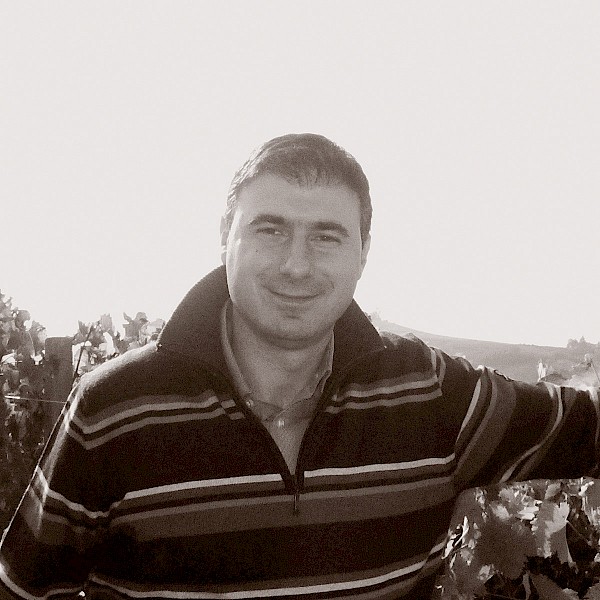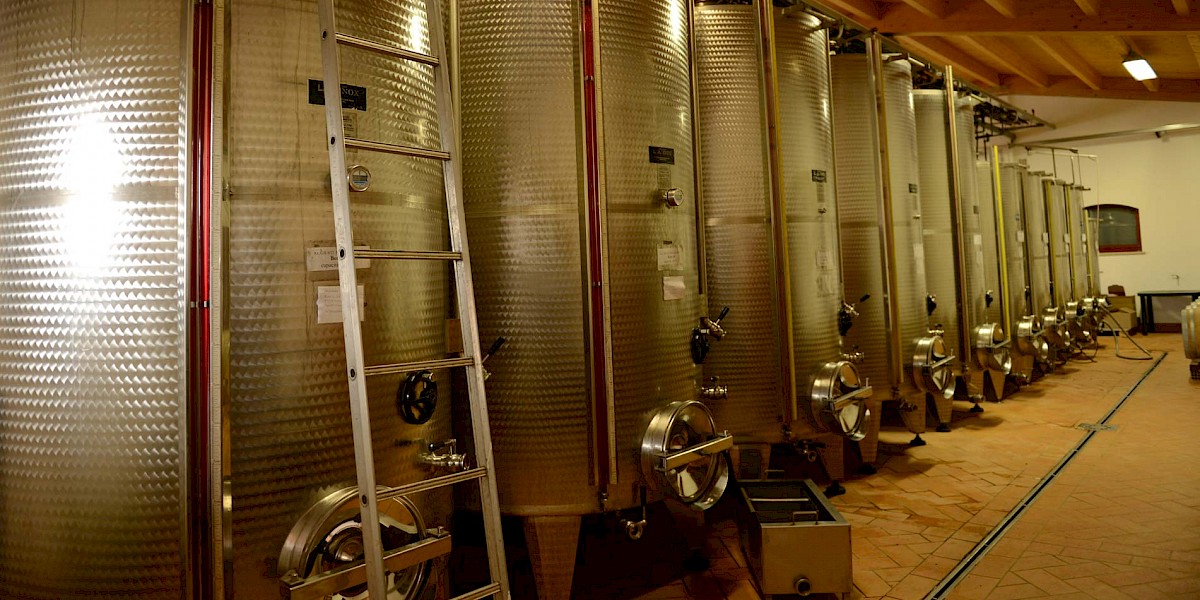Poderi Elia
Piedmont - Italy
The Winery
Simply put, winemaker Federico Stella is a man with an inner drum. Meticulous beyond belief in the cellar, this talented Barbaresco producer possesses an uncanny instinct for balancing taut structure with smooth tannins and remarkable accessibility. Respectful of Piemontese varietals, but unrelenting in his desire to improve, Stella experimented with over 30 combinations of oak before settling on his cooperage formula (an incredible expense for a small estate)! Consistently, he takes all of his wines right up to the edge of modernity, but then masterfully hovers there, never once crossing the line nor stumbling. Moreover, the partial use of French oak (for most of his reds) aside, Federico employs highly traditional methods - his wines, for example, are neither filtered nor clarified.
Sitting down to taste wine at the family’s dinner table, we also get to see the patience and love Federico shows his family. While affable, he always remains serious while discussing his vision. (Indeed, even when the subject of conversation drifts away from Poderi Elia, one always has the distinct impression that, privately, Federico is still thinking about his wine.) With 9 hectares of vines all managed by hand, no corners are cut – yields remain at one bottle per plant regardless of price point. Doubtless, his great grandfather - who founded the estate in 1890 – would be enormously proud.
One of just four villages that comprise the Barbaresco zone, Neive sits perched in the subalpine hills just NE of Alba and some 90 minutes north of the sea. Also, it lies within the Langhe Hills - famous for their Nebbiolo - in the province of Cuneo (which also includes the Alba and Barolo growing zones). Unusually, Neive itself also has some overlap with the Asti designation, which is why we sometimes see Barbara d’Alba or Barbaresco producers making Moscato d’Asti on the same, single estate. Like much of Italy’s north, this entire area once lay under the sea, and its “blue tufo” (the shell-strewn, calcareous clay that promotes big tannins and fierce acidity) still bears a name that recognizes its prehistoric, oceanic beginnings.

- Enologist
- Federico Stella
- Grapes Grown by Winery
- Arneis, Barbera, Dolcetto, Nebbiolo
- Vineyard Size
- 9.0 ha
- Winemaker
- Federico Stella
- Winemaker Biography
- Federico Stella is one of those pensive, unflagging producers who has contributed to Piedmont’s sterling reputation for wine. Everything he creates is the result of meticulous thought and patience, with his opus of Barbaresco slowly building over time.
- Winemaker Generation
- 4th

Barbaresco Serracapelli DOCG
From the heart of the Langhe comes this stunningly elegant, single cru Barbaresco from Poderi Elia. The Stella family has been making wine in the town of Neive since 1890, but only recently have they begun to garner international attention. Tasting the wine today, it is easy to understand why. The spectacular bouquet offers tones of red currant and Morello cherry layered over toasty oak; the structure is marble-solid, with fine-grained tannins that perfectly compliment the powerful Nebbiolo fruit.
- Color
- Deep garnet
- Nose
- Dark cherry, balsamic, exotic spice
- Palate
- Full-bodied, with chewy tannins and a long finish
- Finish
- Firm, complex, long finish
- Vineyard Location
- Barbaresco DOCG, Piedmont
- Vineyard Size
- 1 ha
- Varietals List
- 100% Nebbiolo
- Farming Practices
- Sustainably farmed, including dry-farmed; grapes picked by hand
- Elevation
- 450 m
- Soils
- White tufo (clay) and sand
- Maturation Summary
- Bottled for 10-12 months
- Alcohol
- 14.0 %
- Acidity
- 6.1 g/liter
- Residual Sugar
- 3 g/liter
- Annual Production
- 3,600 bottles
Barbaresco Serracapelli DOCG
From the heart of the Langhe comes this stunningly elegant, single cru Barbaresco from Poderi Elia. The Stella family has been making wine in the town of Neive since 1890, but only recently have they begun to garner international attention. Tasting the wine today, it is easy to understand why. The spectacular bouquet offers tones of red currant and Morello cherry layered over toasty oak; the structure is marble-solid, with fine-grained tannins that perfectly compliment the powerful Nebbiolo fruit.
- Color
- Deep garnet
- Nose
- Dark cherry, balsamic, exotic spice
- Palate
- Full-bodied, with chewy tannins and a long finish
- Finish
- Firm, complex, long finish
- Vineyard Location
- Barbaresco DOCG, Piedmont
- Vineyard Size
- 1 ha
- Varietals List
- 100% Nebbiolo
- Farming Practices
- Sustainably farmed, including dry-farmed; grapes picked by hand
- Elevation
- 450 m
- Soils
- White tufo (clay) and sand
- Maturation Summary
- Bottled for 10-12 months
- Alcohol
- 14.0 %
- Acidity
- 6.1 g/liter
- Residual Sugar
- 3 g/liter
- Annual Production
- 3,600 bottles
Barbera d’Asti DOCG Superiore Abletti
Federico Stella has very old Barbera vines on his Barbaresco estate, and he refuses to tear them out in favor of the more valuable Nebbiolo, as the wines they produce are so tremendous. Hence, his Barbera d’Asti - smooth, nuanced, and neo-classically styled. Freshly pressed cranberries on the nose are accentuated by lush, bright pomegranate. And, as always with the wines of Federico Stella, the tannins are very softly integrated, always granular and unimposing. A truly sophisticated take on this iconic variety.
- Color
- Intense ruby
- Nose
- Ripe red fruit including raspberry
- Palate
- Elevated, with dark plum, cherry and “discreet” tannins
- Finish
- Layered and mouth-watering
- Vineyard Location
- Barbera d’Asti DOCG, Piedmont
- Vineyard Size
- 4 ha
- Varietals List
- 100% Barbera
- Farming Practices
- Sustainably farmed, including dry-farmed; grapes picked by hand
- Elevation
- 300 m
- Soils
- Calcarious clay
- Maturation Summary
- In neutral barrels for 8-10 months and bottled for 1 month
- Alcohol
- 14.0 %
- Acidity
- 6 g/liter
- Residual Sugar
- 2 g/liter
- Annual Production
- 18,000 bottles
Dolcetto d’Alba DOC
From Barbaresco producer Federico Stella comes this truly wonderful, old-fashioned Dolcetto. Clean, stinging rhubarb, pleasant toastiness, and bright red fruits mingle with just a touch of sweet cigar smokiness. Very smooth with “cashmere” tannins. A perfect example of the classic Piemontese style in an everyday, artisinal wine.
- Color
- Ruby red with purple highlights
- Nose
- Dark cherry and red plum
- Palate
- Fresh, young tannins with a bright, balanced acidity
- Finish
- Easy drinking, smooth, medium finish
- Vineyard Location
- Dolcetto d'Alba DOC, Piedmont
- Vineyard Size
- 4 ha
- Varietals List
- 100% Dolcetto
- Farming Practices
- Sustainably farmed, including dry-farmed; grapes picked by hand
- Elevation
- 330 m
- Soils
- White tufo (clay) and sand
- Maturation Summary
- Bottled for 3 months
- Alcohol
- 13.0 %
- Acidity
- 5 g/liter
- Residual Sugar
- 2 g/liter
- Annual Production
- 15,600 bottles
Padrun Langhe Nebbiolo DOC
Coming from the same, small, hillside cru (Serracapelli) as his Barbaresco, Federico Stella over-delivers here with his “basic” Nebbiolo. With older vines grown at 450 meters, we get the intense tannins and vibrant fruit we’ve come to expect from the Langhe, but the weave is integrated and approachable. Tangy, dark cherries, warm raspberry, salty chalk, cedar and chocolate all round out the palate of this great, everyday value.
- Color
- Ruby red
- Nose
- Dark forest berries with hint of rose
- Palate
- Intense, full-bodied, and slightly dry, with well-integrated tannins
- Finish
- Fine grain tannins, balanced finish
- Vineyard Location
- Langhe DOC, Piedmont
- Vineyard Size
- 1 ha
- Varietals List
- 100% Nebbiolo
- Farming Practices
- Sustainably farmed, including dry-farmed; grapes picked by hand
- Elevation
- 450 m
- Soils
- White tufo (clay) and sand
- Maturation Summary
- In French barrels for 10-12 months and bottled for 6 months
- Alcohol
- 13.5 %
- Acidity
- 5.1 g/liter
- Residual Sugar
- 2.8 g/liter
- Annual Production
- 6,000 bottles




